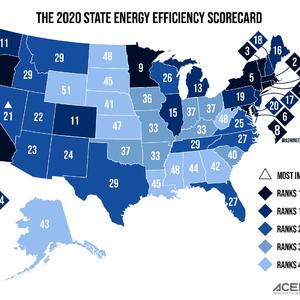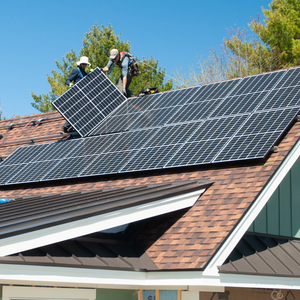Image Credit: Department of Energy / Flickr
Image Credit: Department of Energy / Flickr Investments in energy efficiency and renewable energy produce more jobs than investments in the fossil fuel industry, according to Green Versus Brown, a report authored by Heidi Garrett-Peltier of the University of Massachusetts Amherst.
Democrats on the U.S. Joint Economic Committee pressing for changes in President Trump’s proposed 2018 budget argue that threatened energy-efficiency programs such as Energy Star and the Weatherization Assistance Program (WAP) are potent job creators that deserve continued federal support.
The eight Democratic members of the 20-member panel said in a June minority report that efficiency programs save both consumers and businesses money, reduce carbon emissions, lower government spending, and create well-paying jobs. Jobs related to energy-efficiency technology could grow by 3.3 million over the next decade if given the chance, they said.
The Trump administration has proposed sharp cuts in a variety of federal energy programs in its 2018 budget, including a withdrawal of federal support for both WAP and Energy Star. Congress has yet to act on the budget, and will certainly make changes in the president’s proposal, but the prospect of skimpy federal support isn’t going down well with Democrats on the panel.
The Joint Economic Committee, one of four standing congressional committees, focuses on the economy. Its Republican and Democratic members issue separate reports; this one, a minority report from the Democratic side, was issued on June 9.
It lists the advantages it sees in continued federal funding and says, “Congress must resist efforts to defund successful energy efficiency programs, and instead expand investments that reduce household costs, create jobs, and help the environment along the way.”
Efficiency jobs are up 7% in 2016
Citing a Department of Energy report, the Democratic statement notes that there were 2.2 million U.S. workers in the energy-efficiency sector last year. They are involved in residential and commercial building upgrades, new energy-efficient construction projects, and in manufacturing and installing Energy Star listed products.
Energy efficiency spending represents a “unique financial opportunity,” especially for rural communities, where more than 17% of all households live in poverty, the report said. Jobs are one benefit, but so are lower energy costs.
The report says that energy-efficiency jobs and jobs in renewable energy both offer much higher returns on investment than do fossil fuel jobs (see Image #2, below). Every $1 million invested in fossil fuel jobs produces 2.7 full-time jobs; the same money produces 7.5 jobs in renewable energy and 7.7 jobs in energy efficiency. Owners of businesses engaged in energy efficiency work expect growth of 13% this year, with construction jobs leading the way, the statement said.
Further, for every dollar invested in energy-efficient appliances, consumers get $4 in benefits, the report says. WAP makes a disproportionate impact on the budgets of poor families, who spend almost twice as much of their household budgets on utilities as the wealthy.
“Estimates suggest families participating in the WAP program have saved over $3,000 each in energy bills and benefited from thousands of dollars in health and safety improvements,” the statement said. “Weatherization upgrades also have large, direct health impacts with the potential to increase social welfare by $2.53 for every dollar invested.”
The report says that small businesses currently spend $60 billion a year on energy, with efficiency programs representing a “major opportunity” to lower costs and increase profits. “While these products and retrofits yield long-term returns on investments,” it says, “initial costs on large appliances, retrofits, or retooling business operations can present barriers that prevent end users from reaping the rewards of energy efficiency investments.”
The impact of cuts is not yet known
WAP and Energy Star are but two of a long list of energy-related programs that would feel the pinch of reduced federal spending. The Office of Energy Efficiency & Renewable Energy in the Department of Energy, which supports a variety of energy research programs of use to residential and commercial builders, faces a 69% cut in funds, according to The New York Times.
Efforts by GBA to learn exactly how the proposed cuts would affect programs of interest to builders haven’t turned up much. One official at a government-run research center that works on building energy issues said that staff members had been told not to discuss budget-related issues with the media. But more often than not, officials say it’s just too early to predict spending outcomes.
“It is so early in the process that a clear picture of [Fiscal Year] ’18 is not available until all parties weigh in,” reads one response that sums up the sentiment of a number of others.
There have been a couple of bright spots for building-related programs. Both the Solar Decathlon and the Race to Zero student competitions are going on as planned this year. Building America, an arm of EERE specializing in research on residential buildings, will apparently survive in the 2018 budget.
Asked specifically how the budget would affect Building America, Sofia Mancheno-Gross, a spokeswoman for EERE, said in an email: “The Building America program would continue under the proposed FY 2018 budget.”
Manchero-Gross didn’t offer any further details. Whether she meant that program administrators expected Building America to be completely unaffected, or would continue operating but on a reduced scale, simply isn’t known.
The new EERE chief is no friend to renewable energy
The backdrop to questions over continued federal support on building-related programs includes the president’s appointments to key policy-making positions. Scott Pruitt at the Environmental Protection Agency and Rick Perry at the Department of Energy, both eyed with alarm by environmental and clean energy advocates, will be joined by Daniel Simmons, named last month to oversee EERE.
As described in an article in The Washington Post, Simmons was a member of the Trump transition team and a former vice president for policy at the Institute for Energy Research, a conservative think tank which opposed the international climate agreement and favors fossil fuel use.
In a 2013 podcast, The Post reported, Simmons said: “The most simple of all points is that no matter what the renewable guys say, what they will admit is that their type of power — the wind and solar — is more expensive and will increase the price of electricity. And in an economy that is struggling, it is critical that we do everything we can to keep prices low.”
He has spoken against federal subsidies for renewable energy, including the Ivanpah solar plant in California, and praised fossil fuels as a low-cost power source. “I think that everything should be treated equally across the board,” Simmons said at an energy forum last year, according to The Post. “We have to look at the track record of the oil and gas industry [which is] producing low-cost, reliable energy, particularly when the alternative is much, much higher prices.”
That would be in line with such groups as the Heritage Foundation, which argues that Congress “has empowered agencies to micromanage Americans’ energy use and override personal preferences through energy-efficiency mandates.” Regulations aimed at improving energy efficiency “are as unnecessary today as they were four decades ago,” a position paper at the group’s website says.
The direction that the Trump administration is taking, however, leaves clean energy and environmental advocates angry and troubled. They are people like Brett Hartl, the government affairs director at the Center for Biological Diversity, who calls Trump’s appointments evidence of “the most anti-environmental administration in history.”
Weekly Newsletter
Get building science and energy efficiency advice, plus special offers, in your inbox.
















0 Comments
Log in or create an account to post a comment.
Sign up Log in